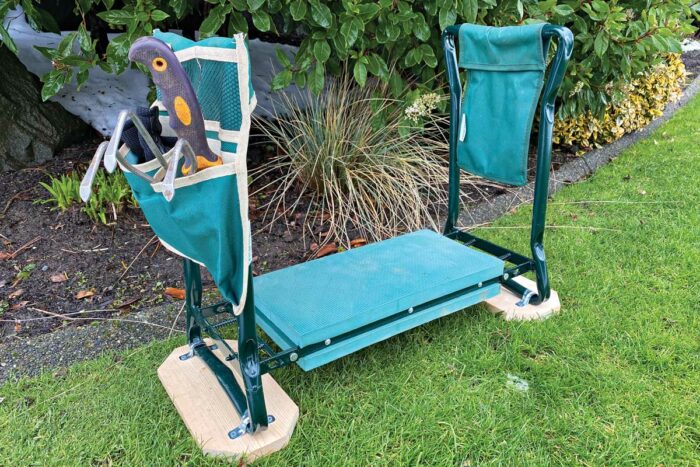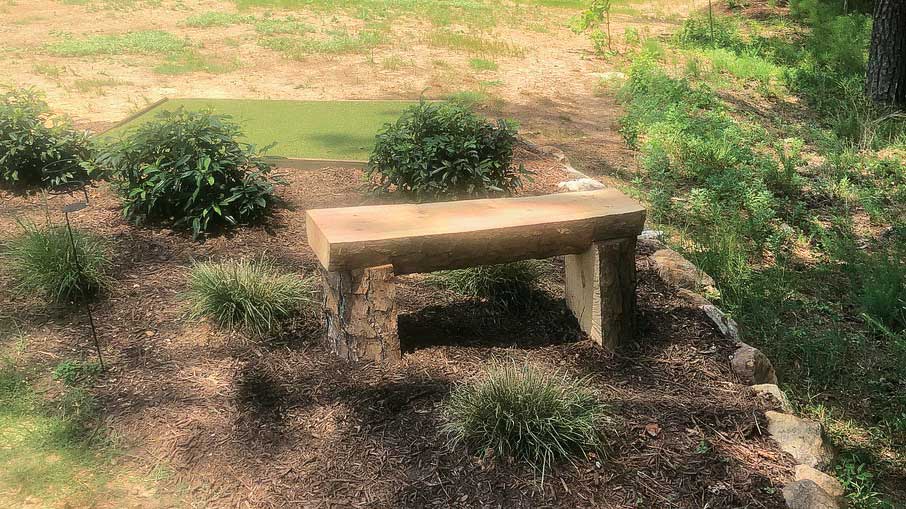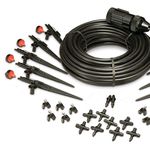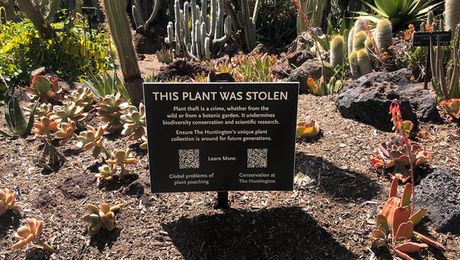
Winning Tip: Kneeler shoes
My granddaughter bought me a garden kneeler for Christmas. I didn’t think I needed one, but it has made planting and weeding easier on my knees while keeping my garden pants cleaner. And I appreciate the assistance getting back up, since I move frequently. However, the ¾-inch tubing used for the frame caused all of my weight to be focused on the two 12-inch sections forming the feet. I was typically leaving 1- to 2-inch-deep tracks all over my lawn and garden. One day I was struck with an idea: I could put shoes on those feet. I cut a 1×6 piece of lumber into two 12-inch pieces, mitered the corners, and screwed them to the feet using ½-inch pipe clamps. Now I leave behind no more than a pair of footprints.
—Scott Bradley, Kirkland, Washington
Plant-shopping help
I enjoy reading about all the fun new plants from each issue of Fine Gardening, and I have found a way to bring the information about them with me when I visit a garden center. I take photos of the relevant pages, then save those photos in a “Plant Wishes” folder on my phone. It is quick to do, and the information is easy to retrieve. I am able to enlarge the photos to read them easily.
—Jean Shipley, Freeport, Illinois
Staking with metallic tubing
Each summer, when the colors and heights of my plants are most apparent, I plan any changes I wish to make to my perennial border. This past fall I decided to add eight dahlias, which require heavy staking. I also needed to know exactly where to plant each tuber come spring. To solve the problem, I purchased two 10-foot lengths of ½-inch electrical metallic tubing (EMT) from a local big box store for the very inexpensive price of $4.30 each. (EMT is easily cut with a hacksaw or tubing cutter into whatever lengths you need.) Using a permanent marker, I wrote the name of the planned dahlia for each location on a piece of the EMT before driving it into the ground. Because the tubing is hollow, it fills with soil as it is driven, helping to keep it firmly in place and vertical. These stakes are permanent, attractive, rust proof, and more than strong enough to support a full-grown dahlia.
—Martha MacDonald, Winchester, Massachusetts

From dead tree to wood bench
I live on a 2-acre lot, and a good portion of it has a number of large oak and pine trees. When one of them dies or falls, I try to make the most of it by splitting all the wood into logs for bonfires or making something useful out of the wood. From some of the larger trees—those 18 inches in diameter or more—I have created wood benches throughout the property. I begin by cutting a 7-foot section of the tree; from that, I cut off two 18-inch logs and set them to the side. I stand the now-4-foot section on end and cut lengthwise through it. Each of these pieces will become a bench seat. To create the legs, I split the two 18-inch logs lengthwise. Returning to the bench seats, I cut a notch under the bench where the two legs will go. I try to leave as much bark on the tree as possible for aesthetics. Then I drill two starter holes through the bench seat into each of the legs and drive in 12-inch spikes to hold everything together. I have created six of these benches throughout my property. The dead trees live on!
—John Matthews, Raleigh, North Carolina
Carrot leaves in salad
I harvest carrot leaves throughout the growing season. I don’t ever throw them out! They are a tasty addition to salads. The greens have a mild carrot flavor and can be taken from small or mature plants. If the plants are small, I only harvest a few of the tender leaves to avoid affecting root growth. The leaves from mature carrots are also tender but should be removed from the tough stems. Unharvested roots that might be too woody can be left in the soil as a source of greens the same year or the following spring, as they will start growing again after winter is over.
—Mary Crum, Holland, Pennsylvania
Send your tips to: [email protected], or mail them to Tips, Fine Gardening, 63 South Main Street, Newtown, CT 06470.
From Fine Gardening #199
Fine Gardening Recommended Products

Johnny’s Selected Seeds Connecta® Cultivation Kit
Fine Gardening receives a commission for items purchased through links on this site, including Amazon Associates and other affiliate advertising programs.

RAINPOINT Sprinkler Timer with Brass Swivel
Fine Gardening receives a commission for items purchased through links on this site, including Amazon Associates and other affiliate advertising programs.
- Built-in metal filter gaskets can prevent sediment and other larger particles
- Through the Sprinkler Timer program, you can set the start time, watering duration, and watering frequency

Rain Bird PATIOKIT Drip Irrigation Patio Watering Kit
Fine Gardening receives a commission for items purchased through links on this site, including Amazon Associates and other affiliate advertising programs.
- Provides drip irrigation for up to 6 planters
- Easy to assemble: just attach to faucet, cut tubing and connect watering devices
- Attaches easily to your outdoor faucet or hose


















Comments
Log in or create an account to post a comment.
Sign up Log in